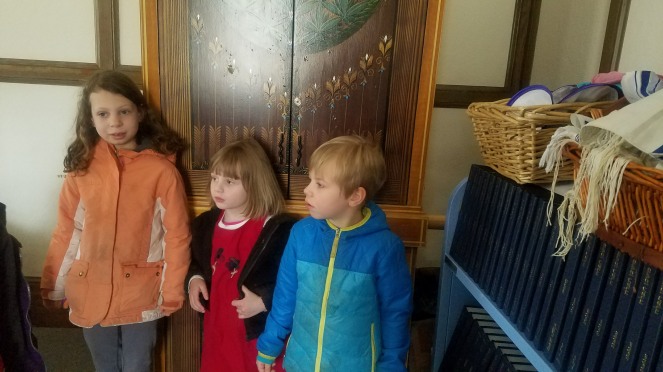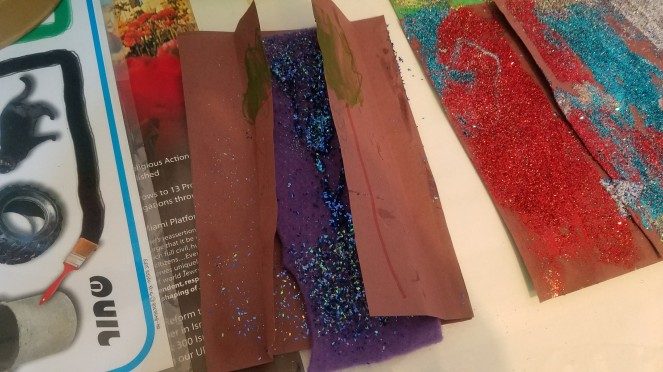Shalom L’CHAIM families! Our final Sunday class of the year was a very special one. We combined the lessons learned in earlier classes to culminate in a moment where we marked our room as a Jewish classroom — by affixing a mezuzah!

The custom of affixing a mezuzah to a doorpost fulfills the biblical commandment: “You shall write them upon the doorposts of they house and upon thy gates” (Deuteronomy 6:9) It distinguishes a Jewish home and is a visible sign and symbol to all those who enter that a sense of Jewish identity and commitment exists in that household. The mezuzah reminds us that our homes are holy places and that we should act accordingly – when we enter them and when we leave them and go out into the world.
The mezuzah and its contents were a theme throughout our L’CHAIM lessons this year: Starting in the fall, we learned to sing and understand the meaning of the Sh’ma prayer, which is our defining prayer about our monotheistic religion. Sh’ma Yisrael Adonai Eloheinu Adonai Echad – Hear O Israel, Adonai is our God, Adonai is One. For Passover we learned about the Children of Israel and how they painted blood on their doorposts to protect themselves from the Angel of Death who would “pass over” the Jewish homes marked on their doorposts. And in our penultimate class we learned about a Sofer, or Scribe, whose job it is to hand-write Torahs and mezuzahs with special ink and on special animal skin called klaf.
We read a lovely story called A Mezuzah on the Door by local writer and educator Amy Meltzer, which is about a little boy who moved from the city to the suburbs, and the special ritual Hannukat Habiyit – Dedication of the Home – that his family had in which they hung a mezuzah on their door. It was a good reminder that the word Hannukah (Chanukah) means “Dedication,” something we also learned about in December when the Maccabees helped “rededicate” the Temple after the Assyrians had dirtied it.
This led into a class discussion about what a mezuzah is, and its origins.
I had invited Rabbi Kevin Hale, a local Sofer, or specially trained Torah Scribe, to join our classroom, but unfortunately he wasn’t able to make it. Rabbi Hale was once the rabbi of Beit Ahavah, in its first year! However, Rabbi Hale loaned me a wonderful book about his Sofer-writing teacher Eric Ray, and he even supplied a blank piece of real klaf (kosher parchment) for us to explore. We took turns touching the parchment and were amazed to think about all the work that went into making it both so rough and so smooth, even before a drop of ink touched it.

Speaking of ink, the book had a recipe for the kosher ink a Sofer uses, which comes from the Talmud! Since I love recipes…
After learning about the mezuzah, what it represents, how it is made and why we hang it, it was time to hang our own mezuzah on the door to our classroom! I was especially excited because it was a pretty mezuzah from Jerusalem I was given as a gift and had wanted to hang at Beit Ahavah. After making the brachah which is the mezuzah blessing:
Baruch Ata Adonai, Elo-heinu Melech Ha-olam, asher kideshanu b’mizvotav v’tzivanu lik-bo’ah mezuzah.
Blessed are You Adonai Our God, Creator of the Universe, who has made us holy by your commandments and commanded us to affix a mezuzah.
And the Shehechiyanu prayer:
Baruch Ata Adonai, Elo-heinu Melech Ha-olam, she’hechiyanu, v’kiyamanu, v’higiyanu la-zman ha-zeh.
Blessed are You Adonai Our God, Creator of the Universe, who has kept us alive, and established us, and brought us to this special moment!
The children helped nail it on our classroom door post with a real hammer, and no fingers were squashed! They nailed it up on the right hand side, tilting in towards the room, and low enough that our smallest students can reach it on tiptoes to touch or to kiss as is a custom when you enter.

Then we finally made our own beautiful mezuzot to hang in our own homes! These are real mezuzah-covers that the children all created out of mosaics, tiles, a wooden mezuzah kit. Rabbi Riqi can help you get a kosher-klaf (parchment with the Hebrew Sh’ma and words written inside) and hang it in your child’s room or a doorpost of your house. They are usually about $18-20 dollars.

We left extra time at the end of class to collect our past art projects and have our snack.
A special thank you to our teen helper Max, who did a fantastic job on the last day.
I can’t believe the year is up, and I hope you will return next year for our expanded and improved L’CHAIM program!! Thank you for being the starting class!!!
 Lastly: On Mother’s Day my daughter surprised me with this card she made at school. It was wonderful to be her teacher, too. (I did not prompt her to make this.) Thank you for a wonderful year!
Lastly: On Mother’s Day my daughter surprised me with this card she made at school. It was wonderful to be her teacher, too. (I did not prompt her to make this.) Thank you for a wonderful year!





